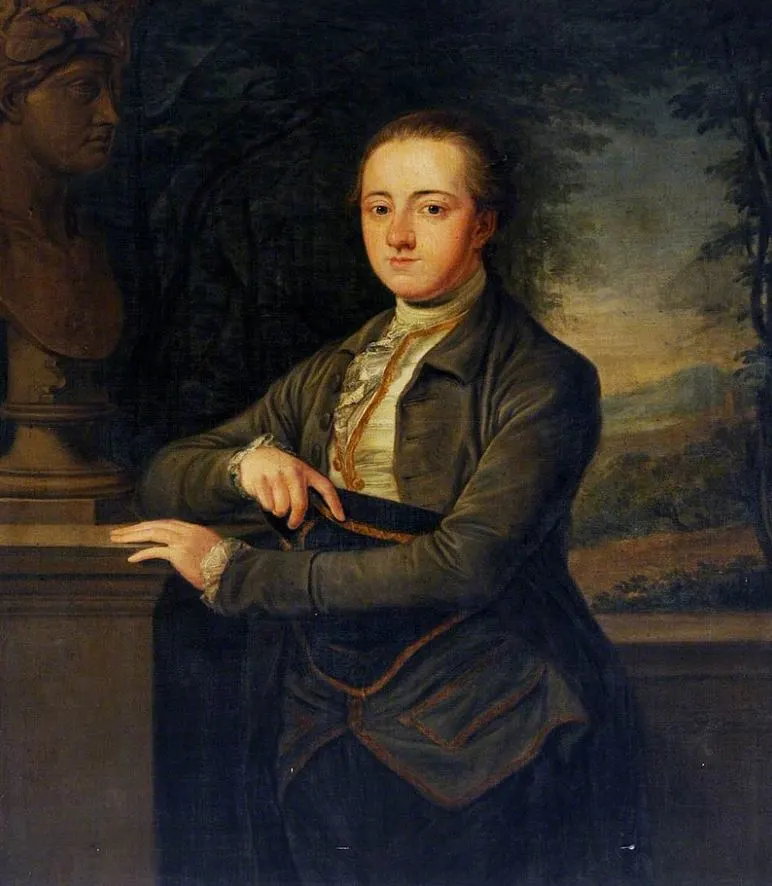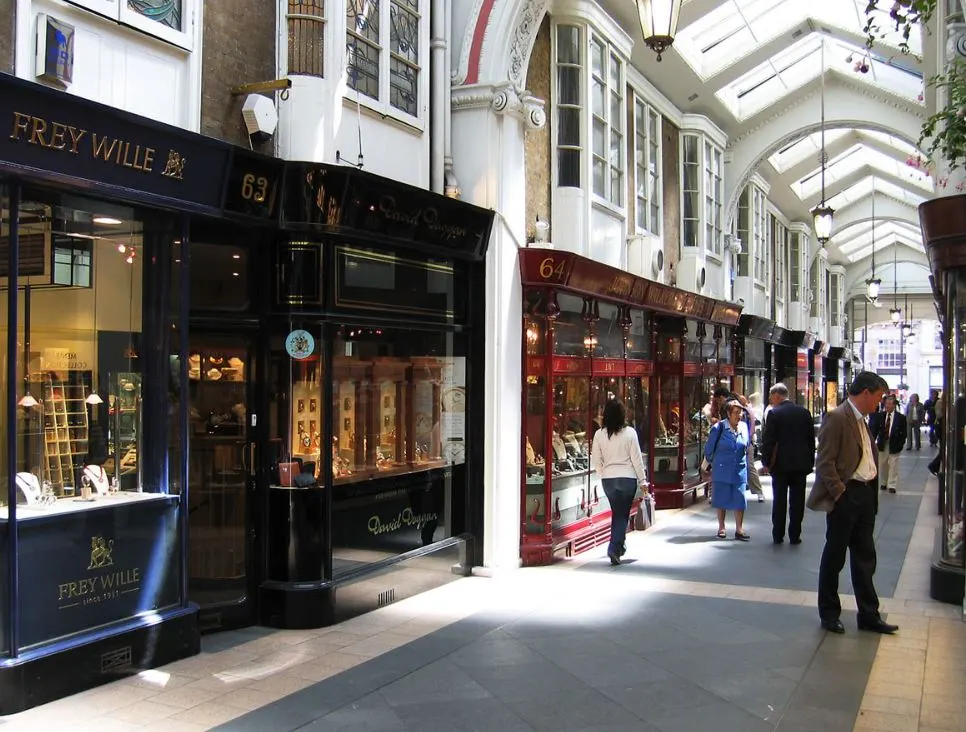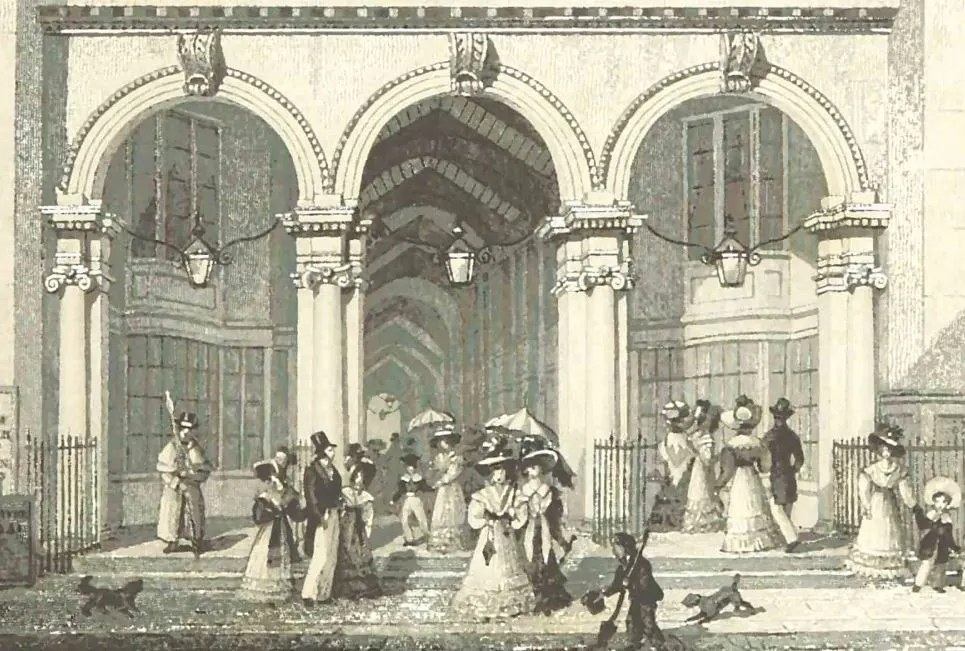The title of the first major shopping mall in the world has sometimes been given to Trajan’s Market in Rome, a structure that was completed in the 2nd century A.D.
Shopping malls as we know them today have their roots in the late 18th century, and more specifically the shopping arcades that were part of the Palais-Royal in Paris.
There have been markets present in London since the Middle Ages, but one of the first covered shopping arcades in the city dates back to the early 19th century.
In this article, you’ll discover some of the most interesting facts about the Burlington Arcade, a shopping gallery and historic building in London with a history of over 2 centuries.
1. It runs just west of the Royal Academy of Arts in the heart of London
Burlington Arcade is one of the multiple covered shopping arcades in London. It runs alongside Bond Street to the east and the Royal Academy of Arts to the west.
Picadilly Circus, one of the most iconic spots in London, is located just walking distance to the east, and Buckingham Palace and St. James’ Park aren’t too far to the south as well.
The arcade has a length of approximately 179 meters (587 feet) and is lined with about 40 shops. This was initially more but some have been merged which reduced the number.
Jewelers and dealers in prestigious silverware made up the initial tenants, but this has been expanded to upscale clothing and footwear shops, as well as art and antique dealers.

2. It was named after the man who commissioned it in the year 1818
The shopping arcade was commissioned in 1818 by George Cavendish, 1st Earl of Burlington (1754-1834). He was both a nobleman and a politician and was later referred to as Lord George Cavendish.

Remarkably, he was only raised to the peerage of Earl of Burlington in 1831, which was about 12 years after the arcade was constructed.
He was also the younger brother of William Cavendish, the 5th Duke of Devonshire (1748-1811), who became extremely wealthy after he married Lady Charlotte Boyle, as she was the only daughter in her family.

3. It was constructed in the side garden of Burlington House for a specific reason
The Earl of Burlington inherited the opulent Burlington House, a Palladian building that had a history as a private residence going back to the 17th century.
The mansion was seriously expanded in the 19th century after it was acquired by the British state. It currently houses the Royal Academy of Arts and 5 other academic societies.
It’ has been speculated’s possible that the Earl of Burlington had the shopping arcade built so people couldn’t throw their garbage inside his garden.
Before the arcade was constructed, his garden had only been separated from the crowded streets of London by a wall which made this very easy to do.

4. There might have been another reason why the Duke had this gallery built
Keeping his garden clean was likely not the only reason why he had this remarkable structure built right next to his own residence.
He actually made a statement about the initial idea behind the shopping arcade:
For the sale of jewelry and fancy articles of fashionable demand, for the gratification of the public.
Whether or not he had a noble goal like this in mind remains uncertain. It has been speculated that he likely had it built to please his wife who liked shopping.
After all, she didn’t have to walk on the muddy streets of London together with all the other common people in the city while enjoying a shopping spree.

5. It was one of the first arcades in London upon completion over 200 years ago
The building was designed by Samuel Ware (1781-1860), the personal architect of William Cavendish, 6th Duke of Devonshire, the nephew of the Earl of Burlington.
He designed many properties for the Duke of Devonshire in both England and Ireland but is best known as the designer of this famous shopping arcade in London.
The arcade was constructed in 1818 and it first opened its doors on March 20, 1819, well over 200 years ago.
Remarkably, upon completion, the arcade featured 72 two-story shops, but this number has been decreased to about 40 today due to several mergers.

6. The façade facing Picadilly features sculptures and was completed in 1911
The original 19th-century entrance on Picadilly Street featured 3 arches but this number was reduced to a single entrance in the early 20th century.
The façade on this famous street in London was completed and redesigned in 1911 and this includes the sculptures that have been carved into it.
This project was completed by Benjamin Clemens (1875-1957), a man who became a professor of sculpture at the Royal College of Art.

7. The arcade is still secured by the traditional 19th-century guards
A large number of upscale shops and jewelers located in a single building made the shipping arcade a popular target for criminals.
It was looted in 1871 and 1936, and a spectacular heist took place here in 1964 when 6 masked men jumped out of a Jaguar X to steal jewelry at the Goldsmiths and Silversmiths Association shop.
Today, the Burlington Arcade is protected by both gates and the traditional guards wearing 19th-century clothes known as “Beadles.”
What’s fascinating about these guards is that they were originally part of Lord George Cavendish’s own cavalry known as the “10th Royal Hussars.”
They do not tolerate noisy individuals, so ye be warned!

8. The shopping arcade was sold for 3 times the amount in just 8 years in 2018
The arcade was acquired by real estate developers Thor Equities and Meyer Bergman in 2010 for a large sum of £104 million.
They instantly hired an architect to redesign the arcade and clearly had the intention to sell it once the renovations were completed.
It came on the property market once again in 2017 at the price of £400 million. It was eventually sold for £300 million to Indian-born British businessmen David and Simon Reuben in May 2018.

